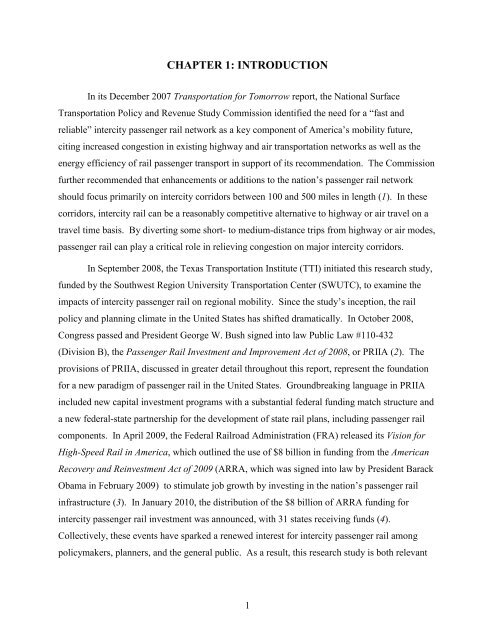Measuring the Benefits of Intercity Passenger Rail: A Study
Measuring the Benefits of Intercity Passenger Rail: A Study
Measuring the Benefits of Intercity Passenger Rail: A Study
Create successful ePaper yourself
Turn your PDF publications into a flip-book with our unique Google optimized e-Paper software.
CHAPTER 1: INTRODUCTION<br />
In its December 2007 Transportation for Tomorrow report, <strong>the</strong> National Surface<br />
Transportation Policy and Revenue <strong>Study</strong> Commission identified <strong>the</strong> need for a “fast and<br />
reliable” intercity passenger rail network as a key component <strong>of</strong> America’s mobility future,<br />
citing increased congestion in existing highway and air transportation networks as well as <strong>the</strong><br />
energy efficiency <strong>of</strong> rail passenger transport in support <strong>of</strong> its recommendation. The Commission<br />
fur<strong>the</strong>r recommended that enhancements or additions to <strong>the</strong> nation’s passenger rail network<br />
should focus primarily on intercity corridors between 100 and 500 miles in length (1). In <strong>the</strong>se<br />
corridors, intercity rail can be a reasonably competitive alternative to highway or air travel on a<br />
travel time basis. By diverting some short- to medium-distance trips from highway or air modes,<br />
passenger rail can play a critical role in relieving congestion on major intercity corridors.<br />
In September 2008, <strong>the</strong> Texas Transportation Institute (TTI) initiated this research study,<br />
funded by <strong>the</strong> Southwest Region University Transportation Center (SWUTC), to examine <strong>the</strong><br />
impacts <strong>of</strong> intercity passenger rail on regional mobility. Since <strong>the</strong> study’s inception, <strong>the</strong> rail<br />
policy and planning climate in <strong>the</strong> United States has shifted dramatically. In October 2008,<br />
Congress passed and President George W. Bush signed into law Public Law #110-432<br />
(Division B), <strong>the</strong> <strong>Passenger</strong> <strong>Rail</strong> Investment and Improvement Act <strong>of</strong> 2008, or PRIIA (2). The<br />
provisions <strong>of</strong> PRIIA, discussed in greater detail throughout this report, represent <strong>the</strong> foundation<br />
for a new paradigm <strong>of</strong> passenger rail in <strong>the</strong> United States. Groundbreaking language in PRIIA<br />
included new capital investment programs with a substantial federal funding match structure and<br />
a new federal-state partnership for <strong>the</strong> development <strong>of</strong> state rail plans, including passenger rail<br />
components. In April 2009, <strong>the</strong> Federal <strong>Rail</strong>road Administration (FRA) released its Vision for<br />
High-Speed <strong>Rail</strong> in America, which outlined <strong>the</strong> use <strong>of</strong> $8 billion in funding from <strong>the</strong> American<br />
Recovery and Reinvestment Act <strong>of</strong> 2009 (ARRA, which was signed into law by President Barack<br />
Obama in February 2009) to stimulate job growth by investing in <strong>the</strong> nation’s passenger rail<br />
infrastructure (3). In January 2010, <strong>the</strong> distribution <strong>of</strong> <strong>the</strong> $8 billion <strong>of</strong> ARRA funding for<br />
intercity passenger rail investment was announced, with 31 states receiving funds (4).<br />
Collectively, <strong>the</strong>se events have sparked a renewed interest for intercity passenger rail among<br />
policymakers, planners, and <strong>the</strong> general public. As a result, this research study is both relevant<br />
1
















